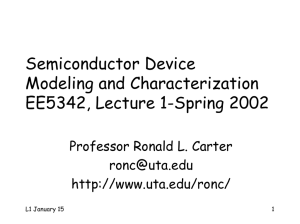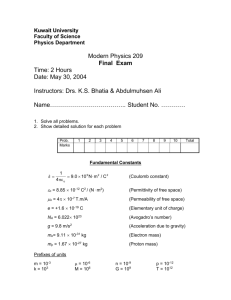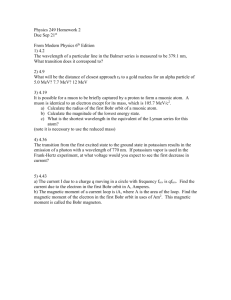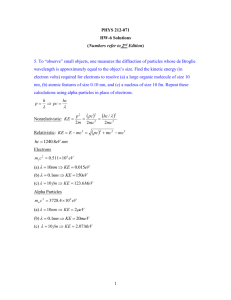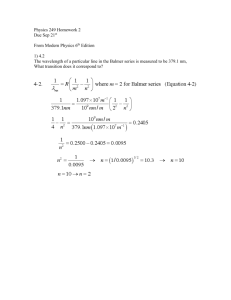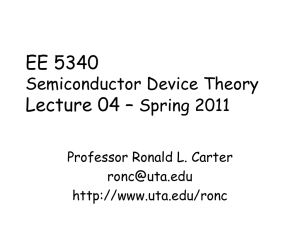document
advertisement
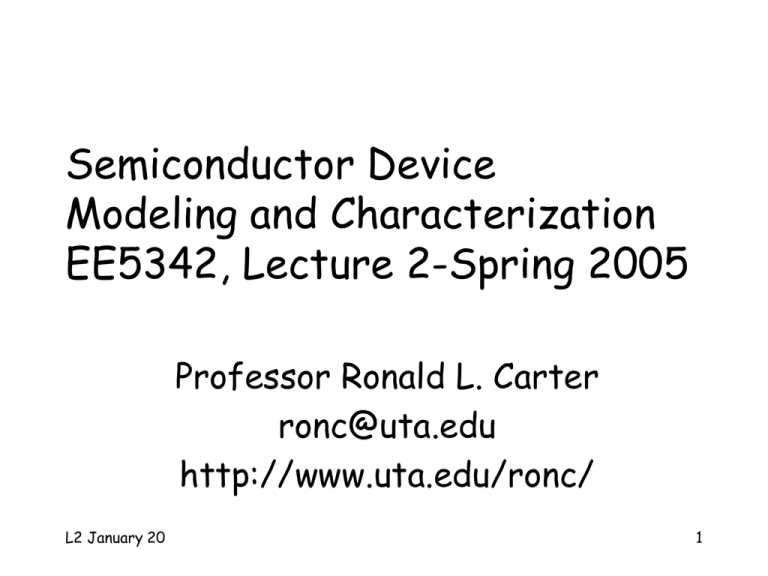
Semiconductor Device
Modeling and Characterization
EE5342, Lecture 2-Spring 2005
Professor Ronald L. Carter
ronc@uta.edu
http://www.uta.edu/ronc/
L2 January 20
1
Web Pages
* Bring the following to the first class
• R. L. Carter’s web page
– www.uta.edu/ronc/
• EE 5342 web page and syllabus
– www.uta.edu/ronc/5342/syllabus.htm
• University and College Ethics Policies
– http://www.uta.edu/studentaffairs/judicialaffairs/
– www.uta.edu/ronc/5342/Ethics.htm
L2 January 20
2
First Assignment
• e-mail to listserv@listserv.uta.edu
– In the body of the message include
subscribe EE5342
• This will subscribe you to the EE5342
list. Will receive all EE5342 messages
• If you have any questions, send to
ronc@uta.edu, with EE5342 in
subject line.
L2 January 20
3
Quantum Mechanics
• Schrodinger’s wave equation
developed to maintain consistence
with wave-particle duality and other
“quantum” effects
• Position, mass, etc. of a particle
replaced by a “wave function”, Y(x,t)
• Prob. density = |Y(x,t)• Y*(x,t)|
L2 January 20
4
Schrodinger Equation
• Separation of variables gives
Y(x,t) = y(x)• f(t)
• The time-independent part of the
Schrodinger equation for a single
particle with Total E = E and PE = V.
The Kinetic Energy, KE = E - V
2y x 82m
E
V
(
x
)
y
x
0
x 2
h2
L2 January 20
5
Solutions for the
Schrodinger Equation
• Solutions of the form of
y(x) = A exp(jKx) + B exp (-jKx)
K = [82m(E-V)/h2]1/2
• Subj. to boundary conds. and norm.
y(x) is finite, single-valued, conts.
dy(x)/dx is finite, s-v, and conts.
*
y
x y x dx 1
L2 January 20
6
Infinite Potential Well
• V = 0, 0 < x < a
• V --> inf. for x < 0 and x > a
• Assume E is finite, so
y(x) = 0 outside of well
2
nx
y x
sin
, n = 1,2,3,...
a
a
2 2
2
2
h n
h k
h hk
En
,p
2
2
2
8ma
8m
L2 January 20
7
Step Potential
•
•
•
•
V = 0, x < 0 (region 1)
V = Vo, x > 0 (region 2)
Region 1 has free particle solutions
Region 2 has
free particle soln. for E > Vo , and
evanescent solutions for E < Vo
• A reflection coefficient can be def.
L2 January 20
8
Finite Potential Barrier
•
•
•
•
Region 1: x < 0, V = 0
Region 1: 0 < x < a, V = Vo
Region 3: x > a, V = 0
Regions 1 and 3 are free particle
solutions
• Region 2 is evanescent for E < Vo
• Reflection and Transmission coeffs.
For all E
L2 January 20
9
Kronig-Penney Model
A simple one-dimensional model of a
crystalline solid
• V = 0, 0 < x < a, the ionic region
• V = Vo, a < x < (a + b) = L, between ions
• V(x+nL) = V(x), n = 0, +1, +2, +3, …,
representing the symmetry of the
assemblage of ions and requiring that
y(x+L) = y(x) exp(jkL), Bloch’s Thm
L2 January 20
10
K-P Potential Function*
L2 January 20
11
K-P Static
Wavefunctions
• Inside the ions, 0 < x < a
y(x) = A exp(jbx) + B exp (-jbx)
b = [82mE/h]1/2
• Between ions region, a < x < (a + b) = L
y(x) = C exp(ax) + D exp (-ax)
a = [82m(Vo-E)/h2]1/2
L2 January 20
12
K-P Impulse Solution
• Limiting case of Vo-> inf. and b -> 0,
while a2b = 2P/a is finite
• In this way a2b2 = 2Pb/a < 1, giving
sinh(ab) ~ ab and cosh(ab) ~ 1
• The solution is expressed by
P sin(ba)/(ba) + cos(ba) = cos(ka)
• Allowed valued of LHS bounded by +1
• k = free electron wave # = 2/
L2 January 20
13
K-P Solutions*
L2 January 20
14
K-P E(k)
Relationship*
L2 January 20
15
Analogy: a nearly
-free electr. model
• Solutions can be displaced by ka = 2n
• Allowed and forbidden energies
• Infinite well approximation by
replacing the free electron mass with
an “effective” mass (noting E = p2/2m
= h2k2/2m) of
2 2 1
h
E
*
m
2
2
4 k
L2 January 20
16
Generalizations
and Conclusions
• The symm. of the crystal struct.
gives “allowed” and “forbidden”
energies (sim to pass- and stop-band)
• The curvature at band-edge (where k
= (n+1)) gives an “effective” mass.
L2 January 20
17
Silicon Covalent
Bond (2D Repr)
• Each Si atom has 4
nearest neighbors
• Si atom: 4 valence
elec and 4+ ion core
• 8 bond sites / atom
• All bond sites filled
• Bonding electrons
shared 50/50
_
= Bonding electron
L2 January 20
18
Silicon Band
Structure**
• Indirect Bandgap
• Curvature (hence
m*) is function of
direction and band.
[100] is x-dir, [111]
is cube diagonal
• Eg = 1.17-aT2/(T+b)
a = 4.73E-4 eV/K
b = 636K
L2 January 20
19
Si Energy Band
Structure at 0 K
• Every valence site
is occupied by an
electron
• No electrons
allowed in band gap
• No electrons with
enough energy to
populate the
conduction band
L2 January 20
20
Si Bond Model
Above Zero Kelvin
• Enough therm energy
~kT(k=8.62E-5eV/K)
to break some bonds
• Free electron and
broken bond separate
• One electron for
every “hole” (absent
electron of broken
bond)
L2 January 20
21
Band Model for
thermal carriers
• Thermal energy
~kT generates
electron-hole pairs
• At 300K
Eg(Si) = 1.124 eV
>> kT = 25.86 meV,
Nc = 2.8E19/cm3
> Nv = 1.04E19/cm3
>> ni = 1.45E10/cm3
L2 January 20
22
Donor: cond. electr.
due to phosphorous
• P atom: 5 valence
elec and 5+ ion core
• 5th valence electr
has no avail bond
• Each extra free el,
-q, has one +q ion
• # P atoms = # free
elect, so neutral
• H atom-like orbits
L2 January 20
23
Bohr model H atomlike orbits at donor
• Electron (-q) rev. around proton (+q)
• Coulomb force, F=q2/4eSieo,q=1.6E-19
Coul, eSi=11.7, eo=8.854E-14 Fd/cm
• Quantization L = mvr = nh/2
• En= -(Z2m*q4)/[8(eoeSi)2h2n2] ~-40meV
• rn= [n2(eoeSi)h2]/[Zm*q2] ~ 2 nm
for Z=1, m*~mo/2, n=1, ground state
L2 January 20
24
Band Model for
donor electrons
• Ionization energy
of donor Ei = Ec-Ed
~ 40 meV
• Since Ec-Ed ~ kT,
all donors are
ionized, so ND ~ n
• Electron “freezeout” when kT is too
small
L2 January 20
25
Acceptor: Hole
due to boron
• B atom: 3 valence
elec and 3+ ion core
• 4th bond site has
no avail el (=> hole)
• Each hole, adds --q,
has one -q ion
• #B atoms = #holes,
so neutral
• H atom-like orbits
L2 January 20
26
Hole orbits and
acceptor states
• Similar to free electrons and donor
sites, there are hole orbits at
acceptor sites
• The ionization energy of these states
is EA - EV ~ 40 meV, so NA ~ p and
there is a hole “freeze-out” at low
temperatures
L2 January 20
27
Impurity Levels in
Si: EG = 1,124 meV
•
•
•
•
•
•
Phosphorous, P:
Arsenic, As:
Boron, B:
Aluminum, Al:
Gallium, Ga:
Gold, Au:
L2 January 20
EC - ED = 44 meV
EC - ED = 49 meV
EA - EV = 45 meV
EA - EV = 57 meV
EA - EV = 65meV
EA - EV = 584 meV
EC - ED = 774 meV
28
Quantum density
of states function
• 1 dim electron wave #s range for n+1
“atoms” is 2/L < k < 2/a where a is
“interatomic” distance and L = na is
the length of the assembly (k = 2/)
• Shorter s, would “oversample”
• if n increases by 1, dp is h/L
• Extn 3D: E = p2/2m = h2k2/2m so a vol
of p-space of 4p2dp has h3/LxLyLz
L2 January 20
29
QM density of
states (cont.)
• So density of states, gc(E) is
(Vol in p-sp)/(Vol per state*V) =
4p2dp/[(h3/LxLyLz)*V]
• Noting that p2 = 2mE, this becomes
gc(E) = {42mn*)3/2/h3}(E-Ec)1/2
and E - Ec = h2k2/2mn*
• Similar for the hole states where
Ev - E = h2k2/2mp*
L2 January 20
30
Fermi-Dirac
distribution fctn
• The probability of an electron having
an energy, E, is given by the F-D distr
fF(E) = {1+exp[(E-EF)/kT]}-1
• Note: fF (EF) = 1/2
• EF is the equilibrium energy of the
system
• The sum of the hole probability and
the electron probability is 1
L2 January 20
31
Fermi-Dirac
DF (continued)
• So the probability of a hole having
energy E is 1 - fF(E)
• At T = 0 K, fF (E) becomes a step
function and 0 probability of E > EF
• At T >> 0 K, there is a finite
probability of E >> EF
L2 January 20
32
Maxwell-Boltzman
Approximation
• fF(E) = {1+exp[(E-EF)/kT]}-1
• For E - EF > 3 kT, the exp > 20, so
within a 5% error,
fF(E) ~ exp[-(E-EF)/kT]
• This is the MB distribution function
• MB used when E-EF>75 meV (T=300K)
• For electrons when Ec - EF > 75 meV
and for holes when EF - Ev > 75 meV
L2 January 20
33
Electron Conc. in
the MB approx.
• Assuming the MB approx., the
equilibrium electron concentration is
no
Emax
gc E fF E dE
Ec
Ec EF
no Nc exp
kT
L2 January 20
34
References
*Fundamentals of Semiconductor Theory
and Device Physics, by Shyh Wang,
Prentice Hall, 1989.
**Semiconductor Physics & Devices, by
Donald A. Neamen, 2nd ed., Irwin, Chicago.
M&K = Device Electronics for Integrated
Circuits, 3rd ed., by Richard S. Muller,
Theodore I. Kamins, and Mansun Chan,
John Wiley and Sons, New York, 2003.
L2 January 20
35
